Stone Flooring: Choosing the Best Option for Your Home
Natural stone flooring is thing of a beauty — as well as being a highly practical choice. Our complete guide will help you to choose the right products for your needs and budget as well as giving on advice on installation and care
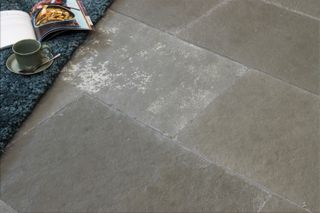
What's not to love about natural stone flooring? It has timeless good looks, durability, is easy to clean and maintain and works brilliantly with underfloor heating.
The only real problem with stone flooring is knowing which type of stone to choose, with there being such a wide choice of materials and styles on offer. Our guide will give you the lowdown on the various stones that work best as flooring, their costs and any pros and cons you should be aware of.
Choosing Stone Flooring
You can trust Homebuilding & Renovating.
There are many different types of stone flooring out there. Your choice should be based on a number of factors, including:
- Your budget
- The expected amount of foot traffic the floor will be exposed to
- What the room will be used for
- The interior style you want to achieve
- The amount of maintenance you are prepared to carry out
Can Stone Flooring be Used Outside Too?
Many natural stone flooring types are suitable for use inside and outside — perfect in situations where you want to create a seamless flow from inside to out.
These include limestone, sandstone, slate, granite and even marble. The key thing to ensure is that the tiles you buy are flagged as being suitable for outdoor use and are in a thickness suitable for their application.
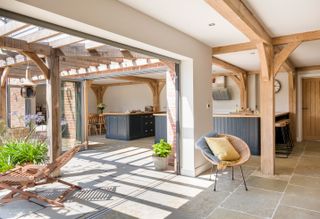
Limestone Flooring
Limestone is a sedimentary rock composed of calcium carbonate and organic matter.
When is comes to limestone flooring, you should know that there are many different limestones from around the world, including the UK, and they have characteristic colours and markings. It’s important to realise that limestones also have different densities. The bottom line? A higher density generally offers better durability and stain resistance.
Limestone flooring should be matched carefully to location, with the densest for high-traffic areas.
In terms of colour, limestone flooring comes in anything from near white to the to honey, grey and even darker browns. Textures range from even-grained surface finishes to smooth, as well as coarser, open-textured varieties. When polished, limestone looks very much like marble.
The price of limestone tiles really can vary. At the cheaper end of things you could find them for approx. £30/m2, although a price of between £50-£80/m2 is the average.

Travertine Stone Flooring
Travertine stone flooring is actually a type of limestone deposited by mineral springs. The way it’s formed means it’s like a honeycomb and these pits and voids are exposed when it’s made into tiles, which gives it a more rustic look than limestone.
Travertine comes in many colour variations, including pale creams and warmer honey shades.
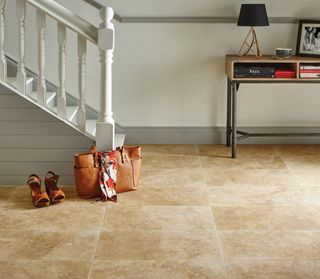
Travertine floor tiles are generally filled with resin – which is colour matched – although some can be purchased unfilled. The voids are then filled during grouting. Holes can re-occur over time — and be refilled. Travertine stone flooring isn’t as hard wearing as limestone, or as stain resistant, but it’s still an attractive choice as it tends to be cheaper.
Travertine is one of the more affordable options for stone flooring, starting from around £15/m2 and rising to around £70/m2.
Slate Flooring
Slate is a good option for those on a budget as it lies at the cheaper end of the market, with some tiles available for as little as £10/m2 from high street retailers. However, do pay attention to quality and seek trusted reviews. If you are after a slate flooring in a less common colour or texture though, prices up to £50/m2 are more likely.
You will find there is a choice between honed (smooth) or riven slate. Riven looks great in more rustic, traditional settings but can be harder to mop clean given its uneven surface.
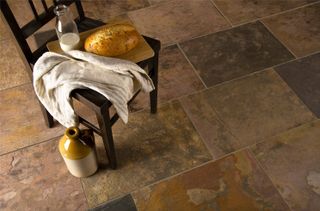
Can Granite be Used for Flooring?
Although most commonly seen as a material for worktops, granite can also make a beautiful choice for those after stone flooring.
Granite comes in a wide choice of colours, often flecked with mineral specks or veining. It is available in different finishes, but a polished finish will be most effective at highlighting its colours and patterns. There is a huge range of colours for granite, from blue and purple to grey, green and even rusty reds.
Granite floor tiles start at £30/m2, although this is likely to be for plain black, small format tiles. For something in a more colourful finish or in a larger format, a price closer to £50-£70m2 can be expected although it would be easy to spend upwards of £150m2.
Bear in mind that although granite is suitable for wet areas, such as bathrooms, highly polished tiles could become slippery. Look out for those with a non-slip surface.
Is Marble Good for Flooring?
There is no question that marble is beautiful and can make a striking material for flooring. That said, it does tend to require a little more care and maintenance than some other natural stone flooring types.
Marble is very porous and water should not be allowed to stand un-mopped as this can cause discolouration. In addition, if it comes into contact with certain acidic substances including some food and drinks, it can stain — using a sealant and reapplying it as necessary should avoid this. Speak to your supplier and installer for advice.
It is also unwise to try to lay marble on a DIY basis. It is heavy and brittle and any mistakes will be costly.
All that said, marble remains a popular flooring choice because it really is strikingly beautiful when installed well and properly maintained. It comes in a huge array of colours, sizes and finishes and will add style and elegance to your interiors.
Wondering how much marble flooring costs? Expect to pay upwards of £50/m2.
If you want to lay limestone flooring in the bathroom, choose a version with low porosity.
(MORE: Bathroom Flooring Guide)
When it comes to travertine, avoiding it in the highest traffic areas will ensure a longer life for your floor and less refilling along the way. Its porosity makes it more liable to be stained by acidic liquids – think citrus juice, for example – so care is needed if you use it in a kitchen.
Colour Choices for Stone Flooring
Cream or beige neutrals might spring to mind when you picture limestone or travertine stone flooring, and there is definitely a huge choice of these tones. But the range of colours is larger than you might expect.
If maximum light reflection is what’s needed, a very pale near-white limestone could be a winner. Stone flooring in darker greys and right through to almost black can look dramatic, but are best used in spaces where there is plenty of natural light. Bear in mind that very light and very dark shades of stone flooring will show up dirt more than those mid-toned tiles.
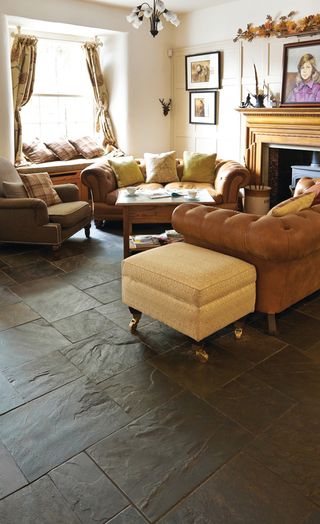
Consider the finish of the stone flooring as this is key to its character. Polished tiles are the glossiest and have a marble-like appearance. The process brings up the colour and markings of the stone. It’s the least slip-proof of the finishes, so factor this in, especially if the floor will get splashed or those not steady on their feet will be using it.
Honed tiles are also smooth, but less glossy than polished — it’s a finish that’s often used for travertine. Tiles that are riven, brushed or tumbled – the names derive from the process that creates the effect – have a more rustic and aged appearance. The texture makes them more slip-proof, too.
How to Lay Stone Flooring
You can lay stone flooring tiles yourself but, given the cost and for optimum results, it’s advisable to call on a natural stone specialist.
“In both new builds and renovations, subfloors need to be level and clean — in most cases this will involve removing existing material and any residual glue. It may be necessary to apply a self-levelling floor screed and, if the subfloor is concrete or screed, check that you have a damp-proof membrane,” says Joss Thomas, founder and designer from Indigenous.
It’s vital that natural stone flooring is sealed before grouting. Stone is naturally porous, and it helps them resist staining. Ask your supplier which sealant is appropriate for the floor tile you’ve selected, as this should take into account both the porosity of the individual stone and its finish.
Which Grout is Best For Stone Flooring?
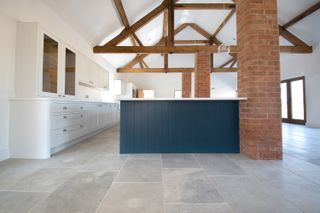
The grout you use with your stone flooring has a big influence on the final look of the floor. “If you’re looking for a seamless finish, try using grout in a shade that coordinates with the tile," says Sian O’Neill, head of marketing at Topps Tiles.
“Opting for contrasting colours can add structure and definition if the tone you pick is complementary. For example, using an ashy grey grout with the lighter, creamier hues of tumbled travertine gives the texture a pop and white grout paired with limestone is great at highlighting each tile’s unique shape and structure.”
Consider the size of the grout joint before the stone floor is laid, too. “Generally, a honed stone with a square edge will look better with a very narrow grout joint, while an aged-looking stone with a pillowed edge will suit a slightly larger grout joint,” says Indigenous’ Joss Thomas.
How to Care For Stone Flooring
Natural stone flooring is hard wearing, but chipping a tile isn’t out of the question. “Replacing individual tiles is difficult, but possible,” says Indigenous’ Joss Thomas.
“Usually, the idea would be to cut around the grout of that specific tile and to chip away at a corner of the tile to break it off. There should then be enough space to get under the tile to lever it up. Any remaining adhesive should then be cleaned away from the subfloor. You need to be very careful not to damage adjoining stone tiles or the pipework of any underfloor heating.”
Sweeping, vacuuming and mopping will keep stone flooring clean, but the right cleaning products are essential. “Avoid general household cleaners, as they tend to be quite acidic,” advises Richard Osborne, managing director at LTP.
Sealant will also need to be reapplied from time to time to maintain the floor’s stain resistance. How frequently depends on the wear the floor gets, but count on doing this every few years.
How Much Does Stone Flooring Cost?
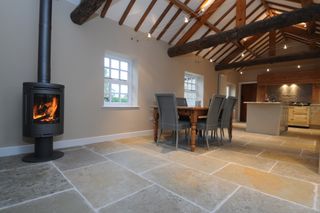
Rarity and accessibility of a stone both have an influence on price.
Prices vary wildly depending on the stone you choose, its source, availability, its thickness and size.
You are also likely to find that choosing reclaimed stone flooring will result in higher price.
Whilst some travertine flooring can be picked up for from £25/m2, it is wise to budget upwards of £30/m², although in reality stones such as limestone can cost over £100/m2. Rare stones for flooring can end up costing £500/m2.
Good Alternatives to Stone Flooring
You can’t claim that your floor’s unique, but man-made tiles can reproduce the look of stone flooring highly effectively for less outlay, and they’re simpler to care for.
“The most important thing is to check how many ‘faces’ the tile has -— this basically means the number of different designs," says Eloise Street of The London Tile Co. "If it’s just one or two you will notice heavy repetition that will not look natural, so go for a higher number.”
You’ll find a huge choice of stone-effect flooring tiles made from porcelain, which is highly durable, and will stand up to high traffic areas.
Ceramic tiles can also pull off the look, although they aren’t as hard wearing as porcelain so are best used away from busy spaces.
Budget from £20/m2 for porcelain and from £15/m2 for ceramic.
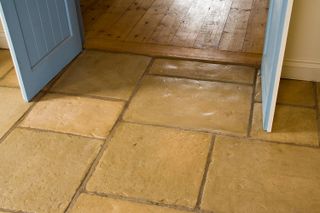
Laying stone-effect tiles yourself should be straightforward. “The floor will need to be levelled and if there is any possible movement or cracks in the subfloor you may also need an uncoupling layer to prevent damage to the tiled surface,” advises Eloise Street.
“Porcelain stone-effect tiles are easy to lay with a standard tile adhesive and require less maintenance than natural stone. If your tiles have a polished surface they might need sealing, so check with your supplier.”
(MORE: Complete Guide to Flooring)
Get the Homebuilding & Renovating Newsletter
Bring your dream home to life with expert advice, how to guides and design inspiration. Sign up for our newsletter and get two free tickets to a Homebuilding & Renovating Show near you.
Sarah is a freelance journalist and editor writing for websites, national newspapers, and magazines. She’s spent most of her journalistic career specialising in homes.
She loves testing the latest home appliances and products, and investigating the benefits, costs and practicalities of home improvement. She is an experienced renovator and is currently remodelling the ground floor of her new home.
She was Executive Editor of Ideal Home and has worked for Your Home and Homes & Ideas. Her work has published by numerous titles, including The Guardian, channel4.com, Houzz, Grand Designs, Homes & Gardens, House Beautiful, Homes & Antiques, Real Homes, The English Home, Period Living, Beautiful Kitchens, Good Homes and Country Homes & Interiors.
